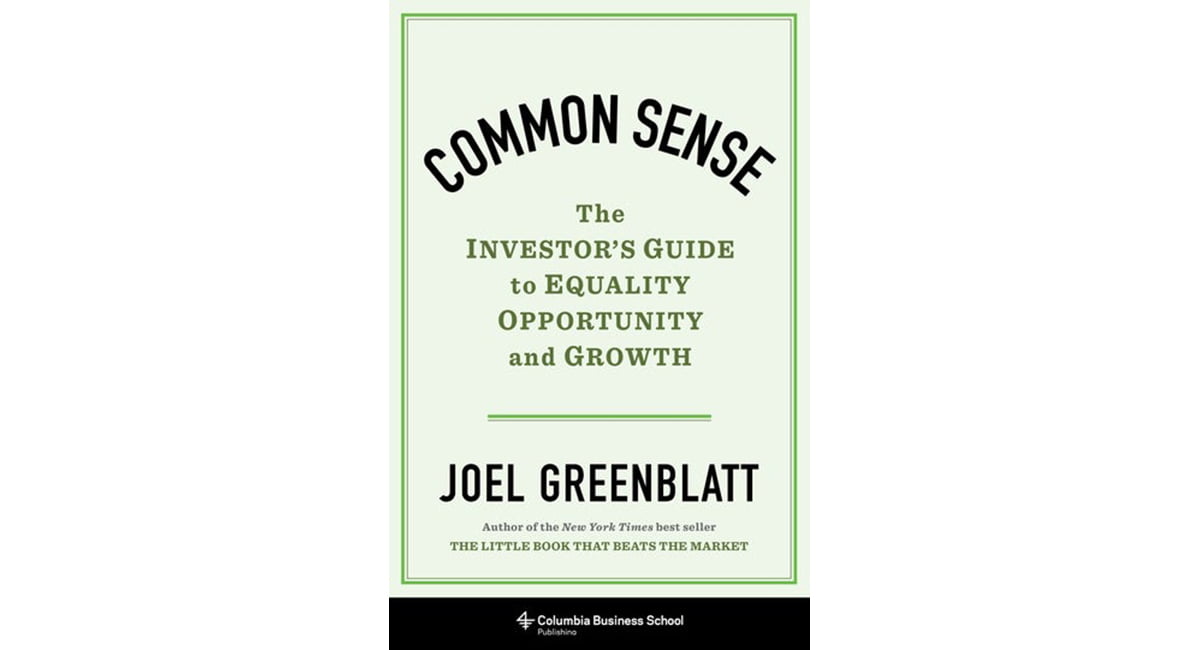Excerpted with permission of the publisher, Columbia University Press, from Common Sense by Copyright (c) 2020 Joel Greenblatt. Used by arrangement with the Publisher. All rights reserved.
Q2 2020 hedge fund letters, conferences and more
So, a few years ago, I was asked to teach a class on investing once a week to a group of ninth graders from Harlem. I eagerly said yes and immediately began to have second thoughts. For over two decades, I’d been teaching a course on investing at an Ivy League business school. After teaching for so long, I knew what I was doing (more or less). Making things even easier, the MBAs knew what they were doing too, with an average age of 27 and three or four years of work experience before getting to me. Teaching a bunch of ninth graders was going to be tougher.
With no money to invest and still years away from a good-paying job, most teenagers don’t care about investing. I wanted them to. I’m pretty sure they just wanted to go to lunch. Undaunted, the first day of class I handed out loose-leaf binders with two charts on the front cover.
One chart had a column of numbers labeled “Investor A” at the top. In this first chart, Investor A invests $2,000 each year into a retirement account starting at age 26. This same investor continues to make annual contributions to his retirement account until age 65, achieving a return of 10 percent per year on his investments. That works out to 40 annual contributions of $2,000.
In the next column, “Investor B” begins at an earlier age. Investor B starts investing $2,000 each year at age 19 and also achieves a 10 percent annual return on his investments. But Investor B only contributes $2,000 each year for 7 years and stops contributing at age 26 (just when Investor A is getting started). That’s only 7 annual contributions of $2,000.
At age 65, who ends up with more money? Investor A or Investor B? The surprise is that Investor B, the one who made just 7 annual contributions when he was young and then never contributed again after age 26, ends up with more money at 65 - $930,641 to be exact. Investor A, who diligently made contributions each year for over 40 years, ends up with less -$893,704. Not bad for Investor A, but not my point.
The point is this: When it comes to saving, investing, and the power of compounding, starting earlier is better - a lot better. But most people don’t. And it’s pretty obvious why.
Adults have lots of expenses - rent and mortgage payments, children, food, clothing, student debt - and saving for retirement doesn’t usually make the list of immediate needs. According to Monique Morrissey, an economist at the economic policy Institute (epI), nearly half of all working-age families have zero retirement savings; the median family between the ages of 32 and 61 has saved only $5,000. The typical working-age, lower-income, black, Hispanic, or non-college-educated family has no retirement account savings at all. Almost 40 percent of Americans, according to one well-publicized study, can’t meet a $400 emergency expense without borrowing or selling something.
So, forget about starting early; many aren’t starting at all. But I know what you’re thinking. What about Australia? Funny you should ask. Australians have been much better about building up their retirement savings. In a program called superannuation, Australians have already collectively saved the equivalent of over 2 trillion U.S. dollars. While that might sound like pocket change to you (assuming you’re delusional), there aren’t that many people in Australia. If we adjust for the relative size of the U.S., that would be like Americans saving almost $30 trillion for retirement in superannuation accounts—close to the combined value of every publicly traded company in the United States. That’s a lot of savings.
How do Australians do it? Are they just more disciplined than Americans? Almost certainly not. They don’t have to be. Fortunately for them, Australians are literally forced to save. Or more accurately, their employers are forced to save on their behalf. employers in Australia must contribute an amount equal to 9.5 percent (growing to 12 percent by 2025) of each employee’s wages and salary to a superannuation fund chosen by the employee.
Collectively, Australians have over 500 professionally managed superannuation funds to choose from. Much of the money contributed can then be channeled back into stocks, bonds, infrastructure, real estate, and the private economy. In most cases, citizens can even voluntarily add additional amounts to the contributions made by their employer. In general, superannuation contributions are tax-deductible for the employer and non-taxable for the employee. So far so good.
But what if that’s still not enough savings to carry Australians through retirement? After all, superannuation only started in the early 1990s, not enough time for many current retirees to accumulate sufficient savings. Luckily, or perhaps prudently, Australia also has an Age Pension that is designed to supplement superannuation savings in the event retirees don’t have enough wealth or income to make it through retirement. So, there we have it. Australia’s retirement system provides for privately controlled retirement accounts supplemented by the government in case that’s not enough. pretty good for them.
What about us? In the United States, we have Social Security. Social Security is also pretty good. employers and employees each contribute 6.2 percent of wages and salary (12.4 percent in total) to the government in exchange for promised retirement or disability benefits later on. The size of benefits received is related to the size of contributions made. Workers earning roughly $50,000, if they retire at 62, receive approximately $15,000 back each year in retirement benefits, or around 30 percent of their working wages. Those with lower incomes receive a slightly higher percentage of working wages, or about 40 percent. That works out to about $9,000 each year for someone with wages of $22,000.
Though the income from Social Security payments is incredibly important for most retirees—many can’t live without them—the size of payments isn’t particularly generous at lower income levels. But even at this limited level of benefits, our Social Security system isn’t very well funded. It’s essentially a pay-as-you-go system where Social Security contributions from current workers are paid out to current retirees.
Yes, we do have a Social Security “trust fund” (invested in U.S. government bonds) that mostly serves to level out fluctuations of contributions due to baby booms and busts, but at the current pace of contributions and payouts, that fund will be gone in about 15 years. As our population ages and the ratio of Social Security recipients to working-age contributors increases, the math starts to work against us. To keep even on our current promises, we’ll likely have to raise our ongoing contribution rate of 12.4 percent by at least 2 percent and also increase the amount of income subject to Social Security taxes (currently, incomes up to $137,700 are subject to the tax).
In addition to tax-advantaged individual retirement accounts (IrAs)—only about 23 percent of Americans have one of these—the other major way we save for retirement in the United States is through pension accounts sponsored by many employers, known as 401(k) plans. employees can designate a certain part of their salary to be contributed to this tax-advantaged retirement savings account, and some employers provide an additional match of a portion of the employee’s contribution. As with IrAs, employees typically have many options for investing the money.
There’s only one problem with all of this.
The people who need retirement accounts the most don’t have them. For the most part, these programs are voluntary. Most people at lower incomes have more immediate needs than saving for retirement. According to epI, “nearly nine in 10 families in the top income fifth had retirement account savings, compared with fewer than one in 10 families in the bottom income fifth.” Only 26 percent of Hispanic families and 41 percent of black families have retirement account savings. even for black and Hispanic families with retirement account savings, the median amount saved is only $22,000—almost insignificant relative to actual retirement needs.
So, what can we do? you see where I’m going here. How about just copying Australia? Instead of contributing to Social Security, let’s divert all of those Social Security taxes to personal retirement accounts like the superannuation accounts that Australians have! That way everyone can start saving and investing as soon as they start working. remember those compound interest tables, Investor A and Investor B. getting started early is the key. “Stealing” those Social Security taxes from the beginning of an employee’s working career and investing them at higher rates of return than U.S. government bonds (while simultaneously supporting increased investment in the private economy) could potentially be a game changer for those who need it the most when retirement comes around.
As long as we’re just spitballing here, what if we also increased the limit on how we assess Social Security taxes. For 2020, the Social Security tax is only assessed on the first $137,700 of income. Why does it stop there? The reason goes back to the original purpose of Social Security. It was designed as a retirement savings program (with some disability insurance attached). Although those at lower income levels get a proportionately larger payout relative to contributions than higher-income participants, Social Security largely sticks to the original notion that what you get out of the program is closely related to your contributions over the years. To preserve that relationship, since Social Security payouts are capped, so are contributions, and that’s where the current $137,700 limit comes from.
If we continue to assess Social Security taxes on those earning more than $137,700 without providing increased retirement benefits, that original relationship between contributions and payouts will be broken. In other words, it would be just like raising tax rates on workers with higher incomes. That may be fine but that decision to raise tax rates should be unrelated to Social Security. If it’s just an increase in tax rates, why shouldn’t we spend the increased tax receipts on helping with childhood poverty, education budgets, better infrastructure, or just name your priority? Why should the benefits of those higher taxes go solely to retirees?
So, here’s why I’m suggesting we keep assessing Social Security taxes beyond the current $137,700 limit. I just proposed we consider changing the nature of Social Security. The 12.4 percent we are currently assessed on wages won’t be taxes anymore. These assessments will become contributions to our own superannuation-like retirement account. But rather than just another tax-advantaged retirement account that mostly benefits the relatively well-off, here’s what we can do. For the amounts assessed on incomes above $137,700, not all of that extra contribution will go into the high earner’s superannuation-like account. Some portion of their contributions, perhaps 15 or 20 percent, will be taken upfront and immediately placed in the accounts of workers earning less than $137,700 based on a formula that favors those at lower income levels.
The compounding benefits for younger and/or lower- income workers receiving these supplemental contributions could be enormous over time. For high earners, these accounts will still maintain tax advantages that should overcome the effects of immediately taking 15 or 20 percent of their contributions off the top to supplement other people’s retirement accounts. yes, we will still need a safety net like Australia’s Age pension (especially during the next few decades) that makes up the difference between currently promised Social Security benefits and what income these new retirement accounts can provide. But the bottom line should be this: everyone will be guaranteed retirement benefits that are at least as generous as our current promises under Social Security.
So, what’s wrong with this new plan to “privatize” Social Security? In short, so much—I don’t know where to get started. But let’s start with this: Most people are bad investors. It’s not even close. expecting individuals to make hundreds of good investment choices over a period of decades in their new private retirement accounts instead of simply continuing to earn benefits through our current Social Security program could turn out very badly.
In 2005, I published a book (The Little Book That Beats the Market) featuring a simple formula to pick stocks that encapsulated the most important principles I use when making my own stock selections. Let’s ignore whether the formula is good or not; hundreds of readers asked for more help in managing their portfolios using the methods in the book. So, I had an idea.
It was based on an idea I had long ago about creating a “benevolent” brokerage firm that sought to protect its customers from the most common investing errors. The firm would still let clients pick individual stocks, but those stocks would have to be selected from a preapproved list based on the principles and formula outlined in the book. We would encourage clients to hold a portfolio of at least 20 to 30 stocks from this list to help create a diversified portfolio and we would send them reminders to make trades at the proper time based on the plan in the book. To make sure customers could pursue this investment strategy over the long term, we wouldn’t allow margin accounts (borrowing). We called these accounts “self-managed.”
At the last minute, we decided to give customers an additional choice: they could just check a box that essentially said “Just do this for me.” This version, which we dubbed a “professionally managed” account, would follow a pre-planned system to buy top-ranked stocks from the list at periodic intervals. No judgment involved—just automatically buy the list and follow the plan.
What was the result? In short, an unintended experiment across thousands of investment accounts. As it turned out, the self-managed accounts, where clients could choose their own stocks from the preapproved list and then follow (or not) our guidelines for trading the stocks at fixed intervals didn’t do too badly. A compilation of all self-managed accounts for the two-year period after we started showed a cumulative return of 59.4 percent after all expenses. Not too bad—except that the S& 500 during the same period was up 62.7 percent.
But a compilation of the “professionally managed” accounts that just automatically followed the rules earned percent after all expenses over the same two year.... Get the full book here.
Excerpted from Common Sense by Copyright (c) 2020 Joel Greenblatt. Used by arrangement with the Publisher. All rights reserved.






